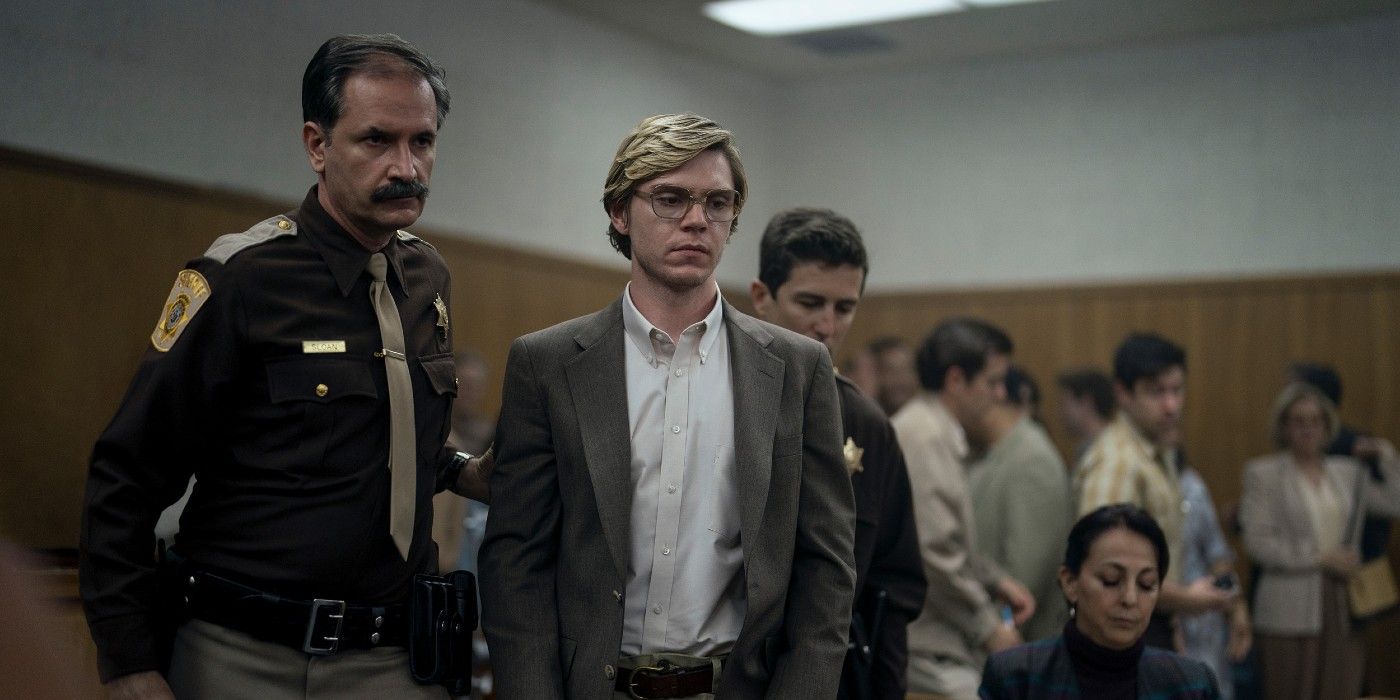This article contains discussion surrounding the real-life crimes of Jeffrey Dahmer, including pedophilia and murder.
Monster: The Jeffrey Dahmer Story covers the shocking murdering spree of the "Milwaukee Cannibal," but the police officers in Monster may have prevented the death of one of Dahmer's youngest victims. Created by Ryan Murphy and Ian Brennan, Monster: The Jeffrey Dahmer Story is a comprehensive retelling of the infamous serial killer's life. The Netflix miniseries stars Evan Peters (American Horror Story) as Jeffrey Dahmer, and Niecy Nash as Glenda Cleveland, Dahmer's suspicious neighbor who calls the police when Konerak Sinthasomphone escaped Dahmer's apartment naked, bruised and drugged. Sinthasomphone's tragic death is retold in the second episode of Monster.
Jeffrey Dahmer lured the 14-year-old boy to his apartment by offering him money to pose for nude photos. There, Dahmer drugged and beat Sinthasomphone before taking photos of his unconscious body. Sinthasomphone escaped and was found outside by Glenda Cleveland, who called the police. Disturbingly, the police left Sinthasomphone with Dahmer, who killed the boy shortly after. In reality, the incident was similar to the Monster's portrayal, although it wasn't Cleveland who found Sinthasomphone outside. Cleveland still has a connection with the event, and Monsters episode 2 ends with the real-life phone call between the police and Cleveland, who was shocked they didn’t help Dahmer's soon-to-be victim.
Why The Milwaukee Police Returned Konerak Sinthasomphone To Jeffrey Dahmer
Although Monster leaves out some details from Dahmer's life, the portrayal of the police officers in Monster who could have prevented Konerak Sinthasomphone's death was largely accurate. The incident occurred in 1991 and involved three officers: John Balcerzak, Richard Porubcan, and Joseph Gabrish. Here's the Monster police officers true story runs much like the show, and on May 27, 1991, Sandra Smith and Nicole Childress found Konerak Sinthasomphone outside Dahmer's apartment and immediately called the police, believing the boy to be no more than 11 or 12 years old.
When the police officers arrived, Dahmer had returned and was holding Sinthasomphone up, which the police claimed wasn't suspicious because Sinthasomphone was not trying to break away. The officers questioned Dahmer, who politely answered everything, including giving officer John Balcerzak his personal information. Dahmer convinced the officers that Sinthasomphone was his 19-year-old house guest called John Mung who had drunk too much, as retold in Monster’s true crime portrayal of the event. Balcerzak repeated his questions to test whether Dahmer was telling the truth, and his answers were the same each time.
At the same time, officer Joseph Gabrish questioned Sinthasomphone, who was unable to respond. Shortly after, Officer Richard Porubcan arrived at the scene to provide backup to the police officers in Monster and in real life. The three officers took Sinthasomphone back to Dahmer's apartment following their questioning, with Gabrish and Porubcan physically carrying Sinthasomphone inside. In Dahmer's apartment, the officers claim to have found no sign of assault and saw the almost nude photos of Sinthasomphone lying around, which convinced them that the pair were in a consensual relationship. Believing that everything checked out, the officers left Sinthasomphone with Dahmer, and the 14-year-old was murdered 30 minutes later.
Why The Police Officers From Monster Were Reinstated After The Dahmer Incident
When Dahmer was arrested in July 1991, he confessed he strangled Sinthasomphone moments after the police officers in Monster had left. Jeffrey Dahmer also admitted that if the officers investigated his apartment, they would have found the body of another victim in his bedroom. The investigation into Jeffrey Dahmer's murders uncovered that the officers failed to validate Dahmer's official identification, which would have shown he was a registered sex offender, having molested Sinthasomphone's older brother in 1988. Following Dahmer's arrest, a recording of Gabrish and Balcerzak making homophobic jokes about reuniting the "lovers" became public and was heavily criticized. The two officers were fired, while Porubcan was briefly suspended.
As for what happened to the cops in Dahmer, both Gabrish and Balcerzak were reinstated a few years later and received back pay, having maintained their claim that they did their best with the information they had. Their reinstatement was criticized, with many believing they had not conducted a thorough investigation because Sinthasomphone was not white and seemingly in a homosexual relationship with Dahmer. Balcerzak went on to become the president of the Milwaukee Police Union and the two officers retired in the late 2010s, despite their involvement in Konerak Sinthasomphone's death.
Why The Portrayal Of Police And Law In Monster Created Controversy
Not everyone was happy about the way the police officers in Monster were depicted. The prosecutor who obtained the conviction against Dahmer, former Milwaukee District Attorney Michael McCann, said he didn't believe the cops in Monster left the boy to die because of the color of his skin. McCann, who admitted he hadn't watched the show, said he knew it would probably paint the prosecutors and law enforcement as racist and homophobic (via Boston Herald). The former prosecutor said that he believes that the police would have acted "swiftly" if they knew they had a serial killer on in their midst. Netflix argued that the police officers in Monster were to blame.
"[The show] exposes these unconscionable crimes, centered around the underserved victims and their communities impacted by the systemic racism and institutional failures of the police that allowed one of America’s most notorious serial killers to continue his murderous spree in plain sight for over a decade"
This also led Monster: The Jeffrey Dahmer Story to become one of the most controversial releases on Netflix in recent memory. The streaming giant didn't take a hit, though, as the show was one of the most-watched true-crime biopics on Netflix when it was released. Much of the controversy surrounded how the show emphasized that the systematic racism in place allowed Dahmer to continue killing since most his victims were people of color. Families of the victims also said that the show brought back the trauma they suffered and condemned telling this serial killer's story all over again.
One of the most controversial parts was when actors playing family members of victims were shown in the reenactments of the court cases. One instance showed Rita Isbell having a breakdown during her testimony. However, Netflix nor Ryan Murphy ever contacted her to ask how she might feel about being portrayed in the show (DaShawn Barnes played Isbell). The real Isbell said she was "bothered" by it and her cousin, Eric Perry, wrote on Twitter that the show recreated his cousin breaking down for entertainment purposes. For his part, actor Evan Peters said the point of Monster: The Jeffrey Dahmer Story was to show the lasting effects Dahmer had on the survivors.

-(14).jpg)

-(15).jpg)
